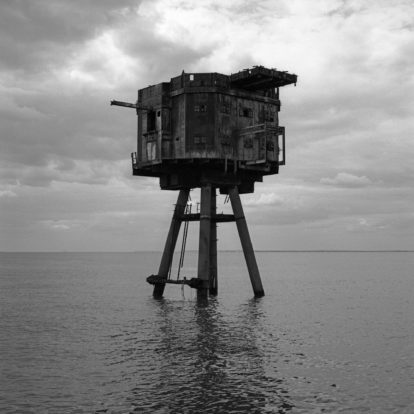‘Jacques Cousteau famously described existence in the ocean as The Silent World. In terms of the coral reef he couldn’t be more wrong.’ Tim Gordon, a specialist in marine bioacoustics, is standing on the top of the biology building at Exeter University, explaining how the analysis of underwater sound is revolutionising our understanding of the ocean. ‘What you can hear is so rich and complex it’s almost like a symphony. The animals are like different players who play at different times – we’re understanding more and more about the way they are communicating and navigating.’
Marine bioacoustics has been attracting increasing international attention in recent years, in part because of a study Gordon is helping to conduct on the Great Barrier Reef. When his research group – led by Dr Stephen Simpson from the University of Exeter – went out there in 2016, they found the reef devastated by bleaching and cyclones. ‘It’s not an overstatement to say it’s the most severe period of degradation we’ve ever recorded,’ Gordon says. ‘On the Northern Barrier reef the mortality of the corals that we saw was between 80 and 90 per cent.’

‘New technology means that we are starting to experience things through the ears of a fish rather than through the ears of a human.’ Illustration: GrandeDuc/Alamy.
Recently marine biologists have started to identify the ways in which sick coral reefs sound different from healthy reefs. This has a direct impact on whether fish – who are essential to the survival of reefs – want to live there. ‘There are almost two layers to the problem’, Gordon explains. ‘You can hear the degradation of the Great Barrier Reef itself simply because it’s much quieter. This in turn has an effect on the fish who start life as an egg on the reef before being washed out to ocean for the first few weeks of their planktonic stage. As they grow up, they listen out for reefs to come back to. If those reefs are quieter, they are less attractive to the fish – and because fish are a key part of the recovery process, this endangers the future of the reef.’
How can scientists analyse underwater communication to such a degree that it’s possible to discover acoustic cues picked up by fish in the planktonic stage? Gordon describes how the team he works with uses the same four measurements that were deployed when bioacousticians from the Universities of Exeter and Bristol were recording sound on the Great Barrier Reef in 2012. ‘There’s Acoustic Richness (AR), in which we’re trying to understand how many different types of sound are represented in the overall soundscape. Then there’s Acoustic Complexity (AC), a measure originally developed for studying birdsong, that analyses how the sound varies over time. There are Sound Pressure Levels which to all extents and purposes are a measure of volume. And Inverterbrate Snap Rates (SR), which are to do with snapping shrimp claws.’
‘What you can hear is so rich and complex it’s almost like a symphony. The animals are like different players who play at different times.’
Tim Gordon
Snapping shrimp claws? ‘That’s the dominant sound source in that eco-system,’ Gordon replies. ‘Snap rate is a measure of how many of those clicks make up that static sound.’ And if there are fewer ‘snaps’, then fish are less likely to come to live in a coral reef. Which is where the revolutionary aspect of the research Gordon and his fellow scientists are doing comes in. Through using underwater speakers to broadcast the sound of healthier reefs – an experiment they have already conducted, creating experimental reefs from coral rubble – they may well be able to entice fish to come and live there.
Yet is this entirely responsible? Surely the reason that fish fail to settle around less healthy sounding reefs is because the conditions aren’t right for them to survive there. Gordon concedes there is a degree of uncertainty about the outcome, but points out that, ‘Fish are a key part of the recovery process for a reef. They form associations with a lot of other animals – invertebrates like sea anenomes are a classic. They also control population dynamics – predators will, for instance, keep populations of sea urchins in balance. But the most important thing is probably their grazing role. Herbivorous fish eat macro algae, which, when corals die, tend to completely take over the reef and stop it from regrowing, because it blocks the light. A high population of fish will eat that algae, and allow the coral to grow again.’
Advances in technology are steadily improving the extent to which marine biologists can interpret and work with underwater communication. ‘A lot of the underwater acoustic equipment we have has been developed because there has been interest from a military perspective,’ Gordon says. ‘Hydrophones are used in submarine detection, and what they pick up is in the Sound Pressure Levels domain. However, as biologists we are also interested in particle motion [the physical vibration of a water column as a sound wave travels through it, which means essentially that fish feel as well as hear sound]. We’re understanding more and more that what fish and other animals are hearing is completely different from what we’re hearing. New technology means that we are starting to experience things through the ears of a fish rather than through the ears of a human.’
How does he see his work developing over the next few years? ‘We’d like to understand more about degradation and acoustic change in other parts of the world. I think we’ll be doing more small-scale research on using loudspeakers to attract fishes back to reefs. It would by no means work as a large-scale global solution. But all of the world’s existing restoration programmes – where they’re growing corals in labs and putting them out there, or creating artificial structure and tying fragments on – are on a scale of a hectare at a time.’
‘There’s a lot of criticism of them for that reason. Of course if we want to restore reefs on any meaningful level globally the only way to do that is to control our carbon emissions. Yet locally these restorations can make a difference – they can restore a fish population for instance, or a fishing village that lives on the beach by a bit of reef. And I think that there is huge value in this.’










